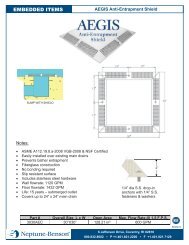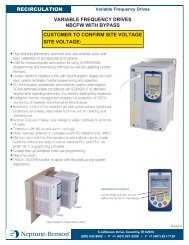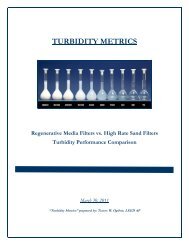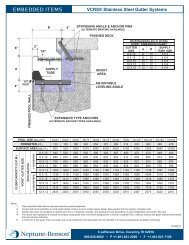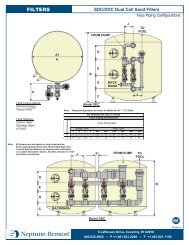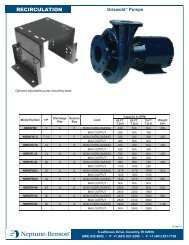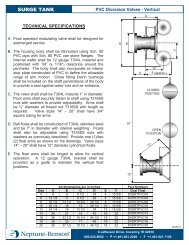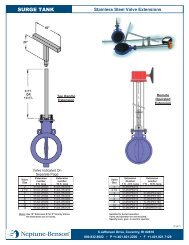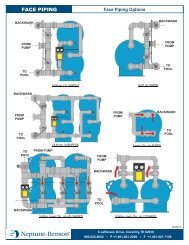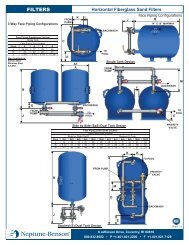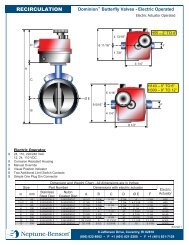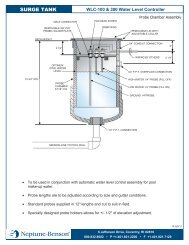See-through - Neptune-Benson
See-through - Neptune-Benson
See-through - Neptune-Benson
Create successful ePaper yourself
Turn your PDF publications into a flip-book with our unique Google optimized e-Paper software.
The voice of the Wet Industry<br />
www.splashmagazine.com.au<br />
February/March 2010<br />
<strong>See</strong>-<strong>through</strong><br />
POOLSACRYLIC<br />
VIEWING PANELS<br />
FINER FILTERS<br />
Improving efficiency<br />
CBD POOL<br />
On the Yarra<br />
GET YOUR ENTRIES IN!<br />
SPLASH! Environmental Awards entry form inside
industry feature<br />
The crystal clear water of Murwillumbah Pool,<br />
which uses filters featuring Zelbrite filter media.<br />
Finer filtration<br />
Media matters in<br />
swimming pool filters.<br />
F<br />
iltration is one of the key components<br />
of a sanitisation system necessary to<br />
provide safe clear water for swimmers<br />
to enjoy.<br />
The most common types of filters use<br />
filter media (most commonly sand). In this<br />
article we’ll be mainly looking at the different<br />
types of media used in filters, in both the<br />
residential and commercial environments.<br />
To start with, John McKenny, instructor<br />
and author of the Easy-to-Unde rstand<br />
Leisure Pool and Spa Handbook, has given<br />
us a quick rundown of the different type<br />
of media and filters. Further in the article,<br />
we will get more specific information from<br />
the manufacturers of some of the types of<br />
filter media.<br />
Sand<br />
(a) Graded filter sand – By far the most<br />
common media used. It is readily available<br />
and transported in bulk bags or easier-tohandle<br />
25kg bags. It’s washed and graded<br />
and quite course compared to normal beach<br />
sand. Although reasonably cheap to buy,<br />
transport costs can make it expensive. It is<br />
32 | SPLASH! www.splashmagazine.com.au<br />
known to last many years. Sand in gravity<br />
filters fifty years old is common. It can be<br />
regularly cleaned using common liquid soap<br />
during a backwash, to assist in removing accumulated<br />
fats and oils, but regular removal<br />
of the surface layers is recommended to<br />
properly remove any build-up of salts from<br />
the pool water and sanitisers. In small pools<br />
such as private installations, a periodic acid<br />
rinse during backwash can assist; but great<br />
care is necessary to protect equipment,<br />
persons and the environment.<br />
(b) Ultra-Fine Sand – Ultra-fine sand<br />
use in swimming pool filtration is so far<br />
limited. It is used in other areas, often in<br />
conjunction with additional equipment such<br />
as centrifuges, to produce high quality air<br />
and sometimes water, filtering down to<br />
less than one micron (one micron = one<br />
millionth of a metre). [Care should be taken<br />
handling dry ultra-fine sand due to potential<br />
health risk from inhalation.]<br />
Sand replacements<br />
(a) Zeolite – There are several brands and<br />
grades on the market. Generally, those who<br />
have experienced operational difficulties<br />
using zeolite have used an inferior (imported)<br />
product. Good quality Australian zeolite gives<br />
excellent results. It is simply substituted<br />
into any “sand” filter and provides an almost<br />
instant improvement in water cleanliness, as<br />
it is claimed to filter down to approximately 3<br />
microns. Although slightly dearer than sand,<br />
it enables less total chemical use, water consumption<br />
and heat loss, as times between<br />
backwashing is often halved.<br />
(b) Glass – Crushed glass can effectively<br />
filter water, having similar properties to its<br />
close relative, sand. Manufacturers advise<br />
that this recycled glass is superior to normal<br />
sand, as it provides better cleaning of the<br />
water and requires less backwashing, saving<br />
on water, heat and chemicals.<br />
Other filtering methods<br />
(a) Cartridge filters – These are common in<br />
small installations. They are usually cheaper<br />
than sand filters for the same pool size,<br />
easier to install and use less water when the<br />
filters need cleaning, as opposed to sand filter<br />
backwashing which can use considerable
industry feature<br />
Diamond Kleen filter media<br />
quantities of water and therefore lose larger<br />
amounts of chemicals and pool water.<br />
(b) Diatomaceous earth filters (DE) –<br />
Proven to be a reliable method of effectively<br />
filtering small to large quantities of water<br />
for both swimming and drinking. DE, in<br />
the form of fine powder, is introduced into<br />
the flow system to form a barrier to all<br />
impurities including bacteria and pathogens<br />
such as giardia and cryptosporidium.<br />
Its drawbacks are that as well as being<br />
sometimes a bit expensive, the DE powder<br />
is considered unsafe if inhaled. Its disposal<br />
after backwashing requires special care.<br />
(c) Perlite – This natural substance is<br />
processed and crushed to a powder and<br />
used in a similar way to DE. According to<br />
those who have used and are still using perlite,<br />
it can be easily backwashed and doesn’t<br />
require cleaning, and therefore replacing, as<br />
often as DE. [However, some large commercial<br />
systems use no backwashing and simply<br />
replace the media].<br />
(d) Granular Activated Carbon (GAC) –<br />
Already used in de-ozonation chambers<br />
where ozone units are in use, GAC can<br />
effectively remove almost all substances in<br />
the water, including tastes, colours if any,<br />
sediment and even chlorine and similar<br />
added chemicals. Some GAC compounds<br />
with special alloys added can filter out all<br />
substances, including cryptosporidium,<br />
giardia and other pathogenic bacteria.<br />
(e) Cellulose fibre – This is used in openstyle<br />
filtering for large commercial projects.<br />
Additionally, pre-filters such as MultiCyclone<br />
can be used to increase filter efficiency<br />
and reduce the backwash requirements.<br />
There are also other types of filtration<br />
that are mainly used for water treatment<br />
industry, such as reverse-osmosis filtration,<br />
in which the water is forced under pressure<br />
<strong>through</strong> a semi-permeable membrane. This<br />
type of filter is used in desalination.<br />
Glass filter media<br />
Dan Kwaczynski of Poolrite, manufacturer of<br />
Diamond Kleen, gives us a rundown on glass<br />
filter media.<br />
There are many forms of filtration available<br />
to the market – DE, sand, zeolite, recycled<br />
glass and more. In this short section, I will<br />
focus on the performance of recycled glass,<br />
(specifically Diamond Kleen) compared to the<br />
performance of sand and other media.<br />
The first question that must be asked is<br />
what are we all looking for in a filtration<br />
media (excluding price which we naturally<br />
all care about). Here are some parameters,<br />
by no means exhaustive list – pressure difference,<br />
level of cleaning (micron rating),<br />
water saving (time between backwashes and<br />
backwash duration), environmental footprint<br />
and longevity/maintenance.<br />
Cleaning ability/micron rating<br />
The primary mechanism by which sand<br />
and zeolites catch particles is by mechanical<br />
entrapment. This is based on<br />
the porous nature with particles caught<br />
in the gaps. Zeolite is far superior to sand<br />
in this regard and cleans to a high level –<br />
less than 10 micron. The performance of<br />
sand, which has a less porous structure,<br />
will naturally be worse than this, perhaps<br />
filtering to 15-20 micron. Diamond Kleen<br />
has a completely different entrapment<br />
mechanism yet still manages to perform to<br />
well below 10 micron. Research has shown<br />
that this primarily relates to an electro<br />
charge that attracts particles. In fact, glass<br />
media is not very porous at all and is actually<br />
quite smooth on the surface. Why is<br />
Niagara Pool Supplies<br />
NSW Ph: 9648 6022 Fax: 9648 6055 • QLD Ph: 5522 0226 Fax: 5522 0955<br />
www.splashmagazine.com.au SPLASH! | 33
industry feature<br />
10 micron an important parameter? This is<br />
generally believed to be the visible range, i.e.<br />
below that and the water will look beautiful,<br />
above and it won’t be quite as clear.<br />
Pressure difference<br />
The pressure difference is an important<br />
parameter because this relates to the size of<br />
pump and the flow rate delivered (and from<br />
this, current draw and carbon footprint).<br />
Porous media will generally have higher<br />
pressure differentials because the water<br />
flows into all the particle gaps, cracks and<br />
pores. By comparison, glass media’s smooth<br />
surface allows water to pass more easily,<br />
hence reducing the pressure loss, and making<br />
the filter more energy efficient.<br />
Another key factor in the performance of<br />
a media is the grading – both in terms of the<br />
minimum and maximum particle sizes and<br />
the spread of media across this range. For<br />
example, too large a grading range and the<br />
smaller particles fill the gaps left between<br />
the larger particles leading to higher differential<br />
pressure and easier clogging. Too<br />
small a grading range or gradings that<br />
are too fine can lead to quicker clogging<br />
and therefore quicker pressure build up.<br />
Diamond Kleen has been specifically engineered<br />
to optimise this delicate balance,<br />
using a highly technical manufacturing process<br />
which includes particle activation.<br />
34 | SPLASH! www.splashmagazine.com.au<br />
Water saving<br />
The water saving ability of a media is based<br />
on two parameters – the ability of the media<br />
to hold waste without increasing pressures<br />
and the time taken to backwash once pressure<br />
has been built up. There is currently<br />
independent research to verify exactly these<br />
two water saving measures for both Diamond<br />
Kleen and zeolite. Both Zelbrite (a brand<br />
of zeolite) and Diamond Kleen have been<br />
awarded the Smart Approved WaterMark. This<br />
is an independent organisation that validates<br />
the water saving capabilities of products.<br />
From experience, both Diamond Kleen<br />
and zeolite have excellent waste holding capacities,<br />
albeit that zeolite requires recharging<br />
at intermittent frequencies (in order to<br />
clean out all the pores). This is not really<br />
surprising when you consider the entrapment<br />
mechanisms mentioned above.<br />
The other parameter to consider is backwash<br />
duration. Given zeolite and sand use<br />
mechanical entrapment, it is clear that the<br />
more deeply embedded particles are in the<br />
structure, and so the longer the backwash<br />
time is needed to completely clear these<br />
particles from the porous structure. By comparison,<br />
glass backwash durations are usually<br />
significantly reduced as the particles are held<br />
loosely on the smooth surface of the particles.<br />
Longevity and maintenance<br />
The limitations of sand are that is breaks<br />
down over time, while zeolite requires<br />
recharging and replacement. Recycled glass<br />
media, by comparison, has a much longer<br />
life expectancy due to the increased hardness<br />
of the material. This can be further<br />
broken down to separate clear sheet glass,<br />
which has a relatively low smelting temperature<br />
and hence lower hardness reading<br />
compared to bottle glass which has higher<br />
smelting temperature and higher hardness<br />
reading. It is therefore expected that glass<br />
media (recycled or new) using bottle glass<br />
will last longer than sheet glass.<br />
Environmental impact of production<br />
Zeolites, sand and new glass require quarrying<br />
operations to produce the base material.<br />
This not only digs into our natural environment<br />
but also uses significant energy to<br />
dig, convey, process, sort, ship, and bag the<br />
product for market. New glass is even worse<br />
– requiring large amounts of heat to melt<br />
the product and transform it into glass.<br />
Recycled glass media is by far the lowest<br />
environmental impact of production. There<br />
is no quarrying and there are no holes being<br />
dug in the landscape. It uses existing material<br />
that was previously destined for landfill, has<br />
been saved and re-used. So in reality, for every<br />
tonne of recycled glass used in filtration that<br />
is one tonne of landfill saved – and potentially<br />
many tonnes of quarrying saved (depending on<br />
the yields of production for sand and zeolite).<br />
The Australian market has embraced the<br />
use of recycled glass media. It is interesting<br />
Zelbrite filter media in sizes 0.5 to 1.0mm (x200)<br />
that only now other markets in the world are<br />
starting to see market growth in recycled glass<br />
media, even though glass media per se has<br />
been used for filtration for many years (there<br />
are even reports that recycled glass was used<br />
more than 20 years ago on Hamilton Island<br />
when no sand was available at the time).<br />
For more information go to www.poolrite.<br />
com.au.<br />
Australian zeolite<br />
Peter Rabbidge of Zeolite Australia, manufacturer<br />
of Zelbrite, talks about zeolite in<br />
general, and Australian zeolite in particular.<br />
Zeolite is a natural mineral found in many<br />
countries around the world and is the result<br />
of volcanic activity.<br />
Not all zeolites are the same. For example,<br />
the zeolites found in Europe, Asia and<br />
New Zealand are very soft and therefore not<br />
suitable to be used as a filter media. These<br />
are mainly used as adsorbents such as Kitty<br />
Litter and for soaking up oil spills.<br />
Zelbrite’s zeolite is mined at Werris Creek<br />
in Northern NSW and is one of the hardest<br />
zeolites found in the world. This filter media<br />
was introduced to the Australian swimming<br />
pool market approximately 10 years ago and<br />
has been used <strong>through</strong>out Australia in both<br />
backyard and commercial pools. It has been<br />
exported around the world and Zelbrite has<br />
recently been selected as the zeolite filter<br />
media of choice by AstralPool in Spain.<br />
Many people have made many claims and<br />
sometimes their claims do not come from<br />
independent testing. For this very reason,<br />
Zeolite Australia chose to have Zelbrite<br />
tested by the Australian Water Quality Centre<br />
(AWQC) whose test results showed it would<br />
give the performance of DE with the convenience<br />
of sand. In the past DE has been held as
industry feature<br />
Right: Perlite media under magnification<br />
Above: Perlite media under 100 times closer magnification<br />
the benchmark for filtration: that is, DE to 5<br />
microns, while sand only filters to 15 microns.<br />
The AWQC test showed Zelbrite could remove<br />
particles as small as 2 microns. Apart<br />
from its superior physical properties, it is<br />
also chemically active removing ammonium<br />
by ion-exchange, resulting in less need for<br />
ancillary chemical requirements to maintain<br />
water quality.<br />
Being a crushed rock it has a very large<br />
surface area and therefore during summer<br />
it will take eight to 10 weeks to reach<br />
backwash pressure, and secondly it takes<br />
half the time to backwash as it roughness<br />
causes it to swirl around inside the filter<br />
shedding the dirt in half the time.<br />
Zelbrite is the only zeolite filter media to<br />
be awarded the Smart Approved WaterMark<br />
and also recently gained Savewater approval.<br />
For more information go to www.zelbrite.<br />
com.au.<br />
Perlite filter media<br />
Perlite is another type of pool filter<br />
media, used pretty much exclusively in<br />
large commercial applications such as<br />
water parks. <strong>Neptune</strong>-<strong>Benson</strong>’s Defender<br />
36 | SPLASH! www.splashmagazine.com.au
industry feature<br />
regenerative media filters are the main<br />
type of filters capable of using perlite, and<br />
applications include WhiteWater World on<br />
the Gold Coast.<br />
David Biber from Australian Perlite<br />
outlines the benefits of the media, and in<br />
particular the Australian product.<br />
Perlite is an important filtration media used<br />
in the clarification of beverages including<br />
beer, wine and fruit juices and in swimming<br />
pool and other water filtration applications.<br />
Perlite is a generic name for a naturally<br />
occurring siliceous volcanic rock. A unique<br />
property of perlite is that it expands up to<br />
twenty times its original volume when it is<br />
heated to its softening range.<br />
This expansion process is caused by<br />
the presence of water in the crude rock.<br />
When perlite ore is rapidly heated to above<br />
850°C, this water vaporises and causes the<br />
softened rock to expand. Tiny glass-like<br />
bubbles are produced which account for the<br />
light weight and exceptional physical properties<br />
of expanded perlite.<br />
It is these lightweight glass-like bubbles<br />
that are milled and classified under<br />
stringent quality controlled conditions<br />
to produce perlite filter aids. This material<br />
exhibits a unique, jagged interlocking<br />
structure with myriad microscopic<br />
channels affording optimum flow rates<br />
and clarities for a wide variety of applications.<br />
Perlite filter aids do not impart taste,<br />
colour or odour to liquids being filtered and<br />
they are virtually insoluble in mineral and<br />
organic acids at all temperatures.<br />
Comparative products such as diatomaceous<br />
earth (DE), sand and zeolite are also<br />
used in filtration. DE does have high crystalline<br />
silica levels and accordingly it is listed<br />
as a potential carcinogen and a Dangerous<br />
Good (DG) under UN protocols.<br />
DE, sand and zeolite are much heavier<br />
than perlite and for a product that is sold by<br />
the kilogram this makes it a more expensive<br />
option than perlite (perlite is at least 30 per<br />
cent lighter than any of these options).<br />
Because perlite stays in solution, it can be<br />
easily and legally disposed of in municipal<br />
sewers while DE requires removal to a DGcertified<br />
land fill.<br />
Australian Perlite (Ausperl) is the primary<br />
supplier of perlite filter media in Australia<br />
and New Zealand. Products are matched<br />
to client requirements. Manufacturing<br />
takes place in Sydney where a disciplined<br />
testing regime ensures that the product is<br />
highly consistent. Due to the bulk density of<br />
perlite, local supply is likely to be the most<br />
economic choice.<br />
For more information go to www.ausperl.<br />
com.au.<br />
RMF and perlite<br />
in water parks<br />
June Holaday from <strong>Neptune</strong> <strong>Benson</strong>,<br />
manufacturer of Defender filters, explains<br />
the benefits of regenerative media filtration<br />
(RMF) in large commercial applications such<br />
as waterparks.<br />
When it comes to waterparks, one of the<br />
toughest obstacles to overcome is public<br />
perception. The visitor sees what appears to<br />
be an endless stream of water flowing all over<br />
the park. What they don’t see are the very strict<br />
measures that parks take to conserve water<br />
behind the scenes. On average, a 100,000<br />
square foot (9300 square metre) waterpark<br />
resort might use 125,000 to 160,000 gallons<br />
of water per day (473,000L to 600,000L). In<br />
comparison, golf courses in the United States<br />
noise!<br />
Make s ome<br />
The Swimming Pool Retail Association Australia (SPRAA) has been created by<br />
technicians and pool retailers to give you a voice on the issues which matter most<br />
to you and your business. Issues like quality assurance and best practice, pool<br />
fencing and licensing legislation, and training and career pathway development.<br />
That’s why we’ve designed a new licensing program in collaboration with<br />
S/T Construction that’s more cost-effective, meets all current state<br />
government requirements and costs only $1,950.<br />
And if you become a SPRAA member you’ll receive a $500 discount*.<br />
Join today at www.spraa.asn.au and<br />
discover the benefits of membership.<br />
*Conditions apply after 31st December, 2009.<br />
www.splashmagazine.com.au SPLASH! | 37
industry feature<br />
Right: The <strong>Neptune</strong> <strong>Benson</strong> Defender<br />
Above: The AquaBoss open filter tank using Purifibre<br />
consume an average of 300,000 to 500,000 gallons<br />
of water per day (1.1ML to 1.9ML). Though<br />
most people don’t seem to associate golf<br />
courses with excessive water consumption.<br />
New technologies are being implemented<br />
<strong>through</strong>out waterparks to reduce, reuse and<br />
recycle water. One of the key elements is the<br />
use of regenerative media filters (RMF) such<br />
as Defender instead of high rate sand filtration.<br />
This popular filtration system requires<br />
no backwashing, saving up to 90 per cent of<br />
wastewater and eliminating the need for a<br />
backwash holding tank.<br />
The RMF technology operates on the<br />
premise of surface filtration, has tremendous<br />
Smart Approved Water<br />
Mark favours four<br />
filtration products<br />
SMART Approved Water Mark,<br />
the not-for-profit program that<br />
helps consumers make informed<br />
choices about saving water around<br />
the home, garden and pool, has<br />
included four swimming pool<br />
filtration products.<br />
Two are filter media – Zelbrite<br />
zeolite media and Poolrite’s<br />
Diamond Kleen recycled glass<br />
filter media.<br />
The other two are Waterco’s<br />
MultiCyclone pre-filter and Ian<br />
Coombes’ AquaBoss commercial<br />
swimming pool filter system.<br />
Products and services with the<br />
Smart Approved WaterMark label<br />
have been assessed by an independent<br />
technical expert panel.<br />
38 | SPLASH! www.splashmagazine.com.au<br />
dirt holding capacity, which extends filter<br />
cycles to weeks or even months. The reduction<br />
in backwash water also means that less<br />
‘make-up’ water needs to be reheated and retreated<br />
with chemicals. Operators report over<br />
30 per cent savings on chemicals and heating<br />
fuel which helps reduce the carbon footprint.<br />
Additional features that reduce the carbon<br />
and water footprints are reduced electricity<br />
usage and saving on construction room.<br />
Regenerative media filters operate at a<br />
lower head (TDH) compared to traditional<br />
sand filters, saving motor horsepower. When<br />
paired with a variable frequency drive (VFD),<br />
electrical usage may be cut up to 30 per<br />
cent. The RMF mechanical footprint requires<br />
less than one-quarter of the space occupied<br />
by sand filters, which significantly saves on<br />
construction costs.<br />
Since so much more waste water is being<br />
eliminated, it becomes critical to maintain<br />
optimum pool water quality. Regenerative<br />
media filters can remove particles down to<br />
1 micron. This allows for more than 99.9<br />
per cent of cryptosporidium to be removed<br />
in a single pass. The superfine filtration<br />
of the water also increases UV sanitation<br />
efficiency. So an additional benefit is that<br />
a regenerative media filter combined with<br />
a UV sanitation system becomes the best<br />
defence against recreational waterborne<br />
illnesses (RWIs).<br />
Australia, suffering its worst drought in<br />
a century, is home to WhiteWater World in<br />
Queensland. According to Angus Hutchings,<br />
the park’s Environmental Manager, the regenerative<br />
media filtration has the most impact<br />
on their water conservation. They use 90<br />
percent less water and save approximately 23<br />
million litres of water per year. Additionally, in<br />
an independent, third party water efficiency<br />
audit conducted by Environmental Resources<br />
Management Australia (ERM), WhiteWater<br />
World has been given the highest efficiency<br />
rating possible for a waterpark.<br />
For more information go to www.DefenderFilter.com.<br />
Commercial filtration with<br />
cellulose fibre<br />
Ben Coombes from commercial filter manufacturer,<br />
Ian Coombes, describes a new<br />
form of filter media – cellulose fibre.<br />
AquaBoss fine media filters use the vacuum<br />
media filtration principal. They operate<br />
by drawing the water <strong>through</strong> an open tank<br />
full of filter elements. Each filter element is<br />
coated with a cellulose fibre called Purifibre<br />
which is a non-toxic, non-carcinogenic media<br />
that provides filtration down to 2-3 microns.<br />
This level of filtration is comparable to<br />
diatomaceous earth without the unwelcome<br />
handling issues. Purifibre is made from<br />
wood pulp just like paper. This makes it a<br />
safe and user-friendly product to work with.<br />
It is a renewable resource and is 100 per<br />
cent biodegradable allowing it to be discharged<br />
direct to the sewer without the need<br />
for large backwash holding tanks.<br />
AquaBoss filters in conjunction with Purifibre<br />
can give filter cycles of eight-to-16 weeks,<br />
therefore using minimal water in comparison<br />
to other filtration types. AquaBoss filters<br />
require 3000 to 9000 litres per backwash,<br />
compared with 10,000 to 15,000 litres used by<br />
a conventional sand filter system.<br />
The filter shell is open to the environment<br />
which makes trouble shooting quick<br />
and easy as the filtration process is clearly<br />
visible. This also has the added benefit of no<br />
pressure in the filtration tank resulting in a<br />
long product life.<br />
For further information go to www.iancoombes.com.au.




